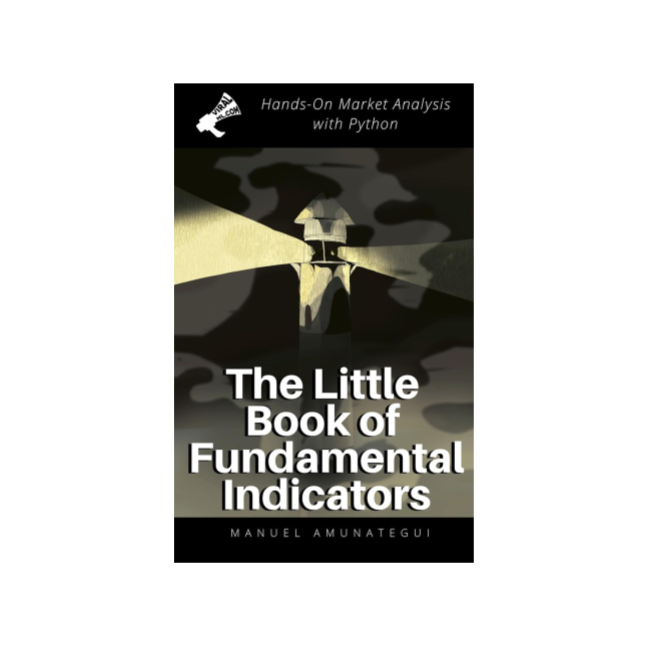
Do You Know How Often The Markets Go Up? Hands-On Market Analysis with Python
Introduction
Lets get back to the basics of market analysis and quantify how many times the markets go up, down and for how much. Its not always intuitive, and whether you are a trader or not, you need to know this. Casino math: https://gaming.unlv.edu/casinomath.html MORE: Blog or code: http://www.viralml.com/video-content.html?fm=yt&v=4kigop8_XXE Signup for my newsletter and more: http://www.viralml.com Connect on Twitter: https://twitter.com/amunategui My books on Amazon: The Little Book of Fundamental Indicators: Hands-On Market Analysis with Python: Find Your Market Bearings with Python, Jupyter Notebooks, and Freely Available Data: https://amzn.to/2DERG3d Monetizing Machine Learning: Quickly Turn Python ML Ideas into Web Applications on the Serverless Cloud: https://amzn.to/2PV3GCV Grow Your Web Brand, Visibility & Traffic Organically: 5 Years of amunategui.github.Io and the Lessons I Learned from Growing My Online Community from the Ground Up: Fringe Tactics - Finding Motivation in Unusual Places: Alternative Ways of Coaxing Motivation Using Raw Inspiration, Fear, and In-Your-Face Logic https://amzn.to/2DYWQas Create Income Streams with Online Classes: Design Classes That Generate Long-Term Revenue: https://amzn.to/2VToEHK Defense Against The Dark Digital Attacks: How to Protect Your Identity and Workflow in 2019: https://amzn.to/2Jw1AYS Transcript Hello Youtube friends, If you had to trade blindfolded? Would you know what to do? Well, if you look at any chart of a big market index, what do you see? Lets get back to the basics, quantify how many time the markets go up, down and for how much. Its not always intuitive, and whether you are a trader or not, you need to know this. Welcome to the ViralML show and another hands-on, market analysis with Python. My name is Manuel Amunategui and this talk will be filed under finance. please subscribe to the channel and to the newsletter. Pause Imagine that Invited you on a journey through time and I asked you to place a trade, long or short on this chart, the caveat being you will be blindfolded, so what would you do? if you had no clue about anything, going long would be the safe strategy. But what about this harder question, what is the percentage or ratio that the markets go up? Yes, not so easy. By simply looking at this S&P500 chart, Id say 2/3s of the time. I can practically hear the statisticians and seasoned traders calling me an idiot and dead wrong. 2/3s would be like 66% percent of the time - boy am I off!!! Lets quantify how many times the S&P 500 had up-days versus down-days and for how much. This is a critical market foundation we all need to have. Its basic probabilities, it the basis of our financial markets, the financial system, the edge market----makers and casion have over regular traders and why thinking in the long term is a safer bet. As always, I like to plug my book at the end of the show - if you like this raw, no-nonsense look at the markets through fundamental indicators, this book is for you. I published it recently on Amazon. put my first and last name in the Amazon search bar you will find it there. In it, I cover my favorite market indicators, like the S&P500, the CPI, the Case-Shiller index, the VIX, unemployment and a whole lot more. dont forget to give this video some thumbs up! CATEGORY:Finance HASCODE:ViralML-How-Often-Do-Markets-Go-Up.html
Code
from IPython.display import Image
Image(filename='viralml-book.png')
Fundamental and Technical Indicators - Hands-On Market Analysis¶
Get the book "The Little Book of Fundamental Market Indicators":
More at:
So, How Often Does the Market Go Up?¶
Download the S&P500 index (^GSPC):
https://finance.yahoo.com/quote/%5EGSPC/
Download the Russell 2000 (^RUT) - The Russell 2000 index is an index measuring the performance of approximately 2,000 smallest-cap American companies in the Russell 3000:
%matplotlib inline
import matplotlib
import matplotlib.pyplot as plt
import io, base64, os, json, re
import pandas as pd
import numpy as np
import datetime
import warnings
warnings.filterwarnings('ignore')
Load Historical Data¶
sp500_df = pd.read_csv('^GSPC.csv')
sp500_df['Date'] = pd.to_datetime(sp500_df['Date'])
sp500_df = sp500_df[['Date', 'Adj Close']]
sp500_df.columns = ['Date', 'SP500_close']
sp500_df.tail()
sp500_df.head()
rus2000_df = pd.read_csv('^RUT.csv')
rus2000_df['Date'] = pd.to_datetime(rus2000_df['Date'])
rus2000_df = rus2000_df[['Date', 'Adj Close']]
rus2000_df.columns = ['Date', 'RUS2000_close']
rus2000_df.tail()
rus2000_df.head()
Simple Visualization using the Adjusted Close¶
fig, ax = plt.subplots(figsize=(16, 8))
plt.plot(sp500_df['Date'], sp500_df['SP500_close'], color='blue')
plt.title('S&P 500')
plt.grid()
plt.show()
fig, ax = plt.subplots(figsize=(16, 8))
plt.plot(rus2000_df['Date'], rus2000_df['RUS2000_close'], color='blue')
plt.title('Russell 2000')
plt.grid()
Let's count up days¶
sp500_df['Previous_Close'] = sp500_df['SP500_close'].shift(1)
sp500_df.head()
# drop NAs
sp500_df = sp500_df.dropna(axis=0)
sp500_df.head()
sp500_df['Price_Diff'] = sp500_df['SP500_close'] - sp500_df['Previous_Close']
sp500_df['Is_Up_Day'] = np.where(sp500_df['SP500_close'] > sp500_df['Previous_Close'], 1, 0)
sp500_df.head()
print('Up days:', np.sum(sp500_df['Is_Up_Day']), 'out of:', len(sp500_df))
print(np.sum(sp500_df['Is_Up_Day']==1) / len(sp500_df))
print(np.sum(sp500_df['Is_Up_Day']==0) / len(sp500_df))
Track up versus down dollar moves¶
np.sum(sp500_df[sp500_df['Is_Up_Day']== 1]['Price_Diff'])
np.sum(sp500_df[sp500_df['Is_Up_Day']== 0]['Price_Diff'])
# let's check our math
37646.364575 - 34836.874673
from random import randint
up_down_days = []
for x in range(0,1000000):
up_down_days.append(1 if randint(1, 100) <= 52 else -1)
up_down_days[0:10]
np.sum(up_down_days)
np.array(up_down_days).cumsum()
plt.plot(np.array(up_down_days).cumsum() )
Show Notes
(pardon typos and formatting -these are the notes I use to make the videos)
Lets get back to the basics of market analysis and quantify how many times the markets go up, down and for how much. Its not always intuitive, and whether you are a trader or not, you need to know this. Casino math: https://gaming.unlv.edu/casinomath.html MORE: Blog or code: http://www.viralml.com/video-content.html?fm=yt&v=4kigop8_XXE Signup for my newsletter and more: http://www.viralml.com Connect on Twitter: https://twitter.com/amunategui My books on Amazon: The Little Book of Fundamental Indicators: Hands-On Market Analysis with Python: Find Your Market Bearings with Python, Jupyter Notebooks, and Freely Available Data: https://amzn.to/2DERG3d Monetizing Machine Learning: Quickly Turn Python ML Ideas into Web Applications on the Serverless Cloud: https://amzn.to/2PV3GCV Grow Your Web Brand, Visibility & Traffic Organically: 5 Years of amunategui.github.Io and the Lessons I Learned from Growing My Online Community from the Ground Up: Fringe Tactics - Finding Motivation in Unusual Places: Alternative Ways of Coaxing Motivation Using Raw Inspiration, Fear, and In-Your-Face Logic https://amzn.to/2DYWQas Create Income Streams with Online Classes: Design Classes That Generate Long-Term Revenue: https://amzn.to/2VToEHK Defense Against The Dark Digital Attacks: How to Protect Your Identity and Workflow in 2019: https://amzn.to/2Jw1AYS Transcript Hello Youtube friends, If you had to trade blindfolded? Would you know what to do? Well, if you look at any chart of a big market index, what do you see? Lets get back to the basics, quantify how many time the markets go up, down and for how much. Its not always intuitive, and whether you are a trader or not, you need to know this. Welcome to the ViralML show and another hands-on, market analysis with Python. My name is Manuel Amunategui and this talk will be filed under finance. please subscribe to the channel and to the newsletter. Pause Imagine that Invited you on a journey through time and I asked you to place a trade, long or short on this chart, the caveat being you will be blindfolded, so what would you do? if you had no clue about anything, going long would be the safe strategy. But what about this harder question, what is the percentage or ratio that the markets go up? Yes, not so easy. By simply looking at this S&P500 chart, Id say 2/3s of the time. I can practically hear the statisticians and seasoned traders calling me an idiot and dead wrong. 2/3s would be like 66% percent of the time - boy am I off!!! Lets quantify how many times the S&P 500 had up-days versus down-days and for how much. This is a critical market foundation we all need to have. Its basic probabilities, it the basis of our financial markets, the financial system, the edge market----makers and casion have over regular traders and why thinking in the long term is a safer bet. As always, I like to plug my book at the end of the show - if you like this raw, no-nonsense look at the markets through fundamental indicators, this book is for you. I published it recently on Amazon. put my first and last name in the Amazon search bar you will find it there. In it, I cover my favorite market indicators, like the S&P500, the CPI, the Case-Shiller index, the VIX, unemployment and a whole lot more. dont forget to give this video some thumbs up! CATEGORY:Finance HASCODE:ViralML-How-Often-Do-Markets-Go-Up.html



